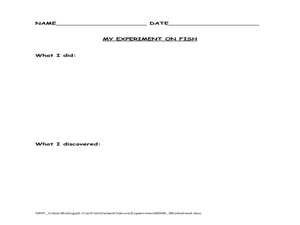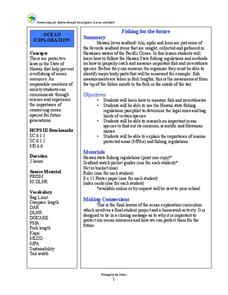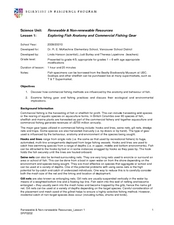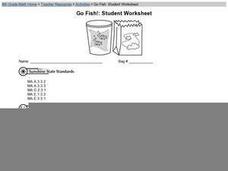California Academy of Science
Fish Prints
What do a dead fish, conservation, and paint have in common? The answer is a great lesson plan about fish anatomy, fun print making techniques, and unsustainable fishing practices. The class will start by making fish prints with a...
Curated OER
Go Fish
Help learners discover methods to estimate animal population. They will participate in a simulation of catching and tagging fish in order to estimate the fish population. They scoop and count goldfish crackers, record data, and use...
Curated OER
Water Ways Lesson Plan #1: Who Catches Your Fish?
Students explore the types of fish caught in the Mid-Atlantic region. In this fishing lesson plan, students learn about fishing methods and meet fishermen that catch the fish. Using the water ways website, students research types of...
Curated OER
How to Catch a Fish
Students conduct an experiment to demonstrate the effects of different fishing methods. In this commercial fishing lesson students create posters and public announcements to share their information.
Curated OER
Fisheries Management in the Open Ocean
Students explore biology by researching fishing equipment. In this oceanography lesson, students discuss the impact of human technology on the fish population. Students utilize marbles as a visual aide and complete fish population...
Curated OER
Sharks in Decline
Students investigate common fishing methods used to capture sharks. They decide why these methods and the shark's reproductive biology are contributing to the quick reduction in the shark population.
Curated OER
Gone Fishing
Students examine the effects of various methods of fishing on fish populations and biodiversity. They read a handout, participate in a simulation of different fishing methods, record the results, and answer discussion questions.
Curated OER
Fish Count
In this science worksheet, students read about how scientists determine the total number of fish in a population. Students also participate in a related math activity.
Curated OER
Urban Biology: Can Fish Detect Odors
Students investigate how fish use their sense of smell. In this scientific method activity, students design and perform an experiment to investigate how fish use their sense of smell. This activity includes statistical analysis and...
Curated OER
Getting to Know Some of Pennsylvania's Fishes
Students research and identify the fish of Pennsylvania. In this earth science lesson, students view ten photos of fish and identify the characteristics of each fish. Students record observations and practice naming the fish using their...
Curated OER
Shoal Destroying
Students investigate methods used in the fishing industry. In this environmental stewardship lesson plan, students visit selected websites to research fishing methods and create a game based around the fishing industry.
California Academy of Science
Academy Seafood Market and Fishery
What fishing method is the most sustainable? Find out through a fun, but meaningful game in which your little fishermen use different techniques to see what they catch. After the fishing activity is over, there are several discussion...
Curated OER
The Aquatic Environment
Fifth graders focus on the various types of fish living in different water environments. In groups, they research the different methods used to fish and participate in experiments to determine the effects of mercury on fish, the...
Curated OER
Management of Commercial Fisheries, Part 2
Students examine the differences between the past vs. the present fishing and the uses of fisheries. In this investigative lesson students complete a worksheet and learn to think critically in order to protect our environment.
Curated OER
Management of Commercial Fisheries
Students examine the differences between renewable and nonrenewable resources and study about past fisheries. In this fishery lesson students explore the complexity of a fishery and its management.
Curated OER
Management of Commercial Fisheries, Part 3
Students search the Internet and write a research paper on the environment. In this investigative lesson students develop a paper on fisheries and management of them.
Curated OER
Alternative Animal Agriculture
Eighty slides dealing with the 6 types of farming alternative animals. Specialty producers and the methods that they employ are detailed and some slides deal with the history and origins of farming and the reasons for commerical use.
Curated OER
Fishing for the Future
Learners research Hawaii's fishing regulations. In this conservation lesson, students explore the reasons behind ocean conservation. Resources are provided.
Curated OER
Designing a Study
Students explore features to consider when designing a scientific study. In this science research lesson plan, students examine different methods of data collection and consider which method would be appropriate for determining how many...
Curated OER
Exploring Fish Anatomy and Commercial Fishing Gear
Students investigate commercial fishing by exploring the technical methods. For this environmental lesson, students identify the fish that are most commonly consumed by humans and trace their path from ocean to plate. ...
Curated OER
Introduction to the Scientific Method
Students participate in an experiment and learn to record it using the scientific method. In this biodegradable plastics lesson, students follow the scientific method to complete an inquiry. Students complete an experiment with a...
Curated OER
Go Fish!
Students collect data, interpret data summarize proportional reasoning. Students determine (with various alternate goods) the number of fish in a nearby pond. Students capture the goldfish crackers, deal with pretzels and then write...
Curated OER
Ethical Ways to Acquire and Distribute Fish as a Food Source
Students complete a variety of activities as they examine the ethics of acquiring and distributing fish as a food source. They touch on the ethics involved in genetically modified salmon, as well.
Curated OER
Go Fish! Student Worksheet
A math and science worksheet prompts learners to simulate how scientists determine populations of animals out in the wild. They use goldfish crackers, paper bags, and a styrofoam cup as their tools. An excellent cooperative group activity!























